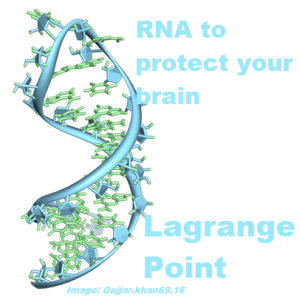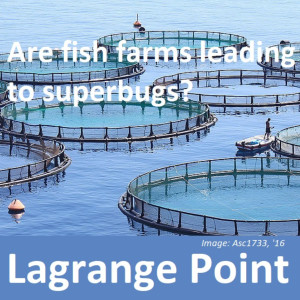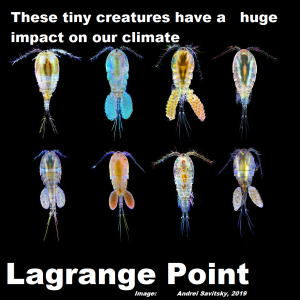Episodes

Monday Apr 26, 2021
Episode 428 - Lightning and Early life on earth
Monday Apr 26, 2021
Monday Apr 26, 2021
What kicked off early life on earth? Organic chemistry and early life need the right minerals to be present and accessible. What helped unlock early minerals on earth like phosphorous to kick start life? Lightning strikes seem rare, but they're much more frequent than meteorites. Early life on Earth could have been helped along through lightning strikes and meteorites. DNA, RNA and Proteins are locked in a complex dance, but which came first. DNA can't replicate without the help of protein and RNA, so how did we develop DNA in the first place? Is it possible for RNA to replicate on it's own?
References:
- Benjamin L. Hess, Sandra Piazolo, Jason Harvey. Lightning strikes as a major facilitator of prebiotic phosphorus reduction on early Earth. Nature Communications, 2021; 12 (1) DOI: 10.1038/s41467-021-21849-2
- Alexandra Kühnlein, Simon A Lanzmich, Dieter Braun. tRNA sequences can assemble into a replicator. eLife, 2021; 10 DOI: 10.7554/eLife.63431

Monday Apr 19, 2021
Episode 427 - RNA protecting your brain
Monday Apr 19, 2021
Monday Apr 19, 2021
How does RNA work to protect your brain and keep it safe after a traumatic event? Micro RNA can play an important role in healthy brain development. Without key micro RNA, the development of the brain can run out of control. Without key microRNA, your can develop neurodevelopmental disorders. Without oxygen your neurons starve, so how can you protect them? How can you use mRNA to make neurons more resilient and recover after a lack of oxygen? Getting proteins across the blood brain barrier is tricky, so can they be snuck in via mRNA? Using mRNA, you can produce proteins to add brain recovery right where they're needed most.
Reference:
- Vijay Swahari, Ayumi Nakamura, Emilie Hollville, Hume Stroud, Jeremy M. Simon, Travis S. Ptacek, Matthew V. Beck, Cornelius Flowers, Jiami Guo, Charlotte Plestant, Jie Liang, C. Lisa Kurtz, Matt Kanke, Scott M. Hammond, You-Wen He, E.S. Anton, Praveen Sethupathy, Sheryl S. Moy, Michael E. Greenberg, Mohanish Deshmukh. MicroRNA-29 is an essential regulator of brain maturation through regulation of CH methylation. Cell Reports, 2021; 35 (1): 108946 DOI: 10.1016/j.celrep.2021.108946
- Merlin Crossley,Dean of Science and Professor of Molecular Biology. (2021, April 09). Explainer: What is rna? Retrieved April 13, 2021, from https://theconversation.com/explainer-what-is-rna-15169
- Yuta Fukushima, Satoshi Uchida, Hideaki Imai, Hirofumi Nakatomi, Kazunori Kataoka, Nobuhito Saito, Keiji Itaka. Treatment of ischemic neuronal death by introducing brain-derived neurotrophic factor mRNA using polyplex nanomicelle. Biomaterials, 2021; 270: 120681 DOI: 10.1016/j.biomaterials.2021.120681

Monday Apr 12, 2021
Episode 426 - Tackling waste water and antibiotic resistance together
Monday Apr 12, 2021
Monday Apr 12, 2021
Hydrogen fuel promises a cleaner future, but the methods to make it are often dirty. A new approach recycles and treats waste water with sunlight to efficiently produce hydrogen. A new electrolysis approach turns waste antibiotics into hydrogen fuel cells. Removing antibiotics and other pharmaceuticals from waster water can be tricky, but a new technique turns that into green energy. Aquaculture is growing rapidly, but it is leading to antimicrobial resistance? What contributes more to antimicrobial resistance - fish farms or waste water? Incorrectly managed waster water can lead to superbugs.
References:
- Yaoyao Wu, Yuqiong Li, Hejing Hu, Guoshen Zeng, Chuanhao Li. Recovering Hydrogen Energy from Photocatalytic Treatment of Pharmaceutical-Contaminated Water Using Co3O4 Modified {001}/{101}-TiO2 Nanosheets. ACS ES&T Engineering, 2021; 1 (3): 603 DOI: 10.1021/acsestengg.1c00003
- Thunchanok Thongsamer, Rattikan Neamchan, Adrian Blackburn, Kishor Acharya, Sawannee Sutheeworapong, Bundit Tirachulee, Pavinee Pattanachan, Soydoa Vinitnantharat, Xin-Yuan Zhou, Jian-Qiang Su, Yong-Guan Zhu, David Graham, David Werner. Environmental antimicrobial resistance is associated with faecal pollution in Central Thailand’s coastal aquaculture region. Journal of Hazardous Materials, 2021; 125718 DOI: 10.1016/j.jhazmat.2021.125718

Monday Apr 05, 2021
Episode 425 - Tiny creatures with a huge impact on our oceans
Monday Apr 05, 2021
Monday Apr 05, 2021
Can you find fresh water in the middle of the ocean? What happens when a geyser of fresh water erupts from the sea floor into the ocean? A sudden freshwater spring can radically change the ocean floor. How do plankton shells and coral help us monitor a changing climate? Life in the oceans can help sequester carbon. We can track the way the climate has changed in the past by studying strontium isotopes in seawater. Changing climates can impact life in shallow and deep water, which can lead to changes in the carbon cycle. Tiny creatures like copepods can have a huge impact on our ocean food web. How do tiny creatures like copepods gather in ephemeral ocean zephyrs. Tiny vortexs can act as a gathering place for tiny but important sea creatures.
- Eric Attias, Steven Constable, Dallas Sherman, Khaira Ismail, Christopher Shuler, Henrietta Dulai. Marine Electromagnetic Imaging and Volumetric Estimation of Freshwater Plumes Offshore Hawai'i. Geophysical Research Letters, 2021; 48 (7) DOI: 10.1029/2020GL091249
- Adina Paytan, Elizabeth M. Griffith, Anton Eisenhauer, Mathis P. Hain, Klaus Wallmann, Andrew Ridgwell. A 35-million-year record of seawater stable Sr isotopes reveals a fluctuating global carbon cycle. Science, 2021; 371 (6536): 1346 DOI: 10.1126/science.aaz9266
- Dorsa Elmi, Donald R. Webster, David M. Fields. Response of the copepod Acartia tonsa to the hydrodynamic cues of small-scale, dissipative eddies in turbulence. The Journal of Experimental Biology, 2021; 224 (3): jeb237297 DOI: 10.1242/jeb.237297

